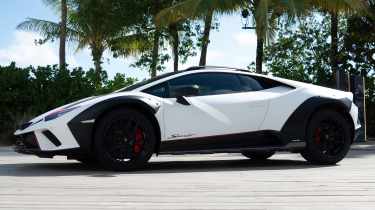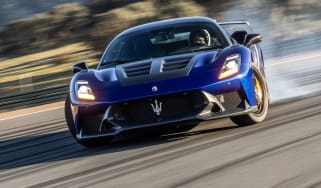Lamborghini Huràcan Sterrato makes debut in Miami
The rally-ready Huràcan Sterrato is proof Lamborghini’s debonair spirit is still alive and well
Lamborghini has formed something of a habit in creating variant upon variant of its V10-powered Huràcan, but we’re not sure even Lambo could have imagined its baby mid-engined supercar would one day be sprouting off road-ready skid plates, roof rails and plastic wheel arch extensions. And yet the 2023 Lamborghini Huràcan Sterrato is here, a fully-homologated off-roading supercar that will also have the role of bringing production of the Huràcan to a close. It’ll be limited to 1499 units, up on the 1063 Lamborghini initially set out to build, suggesting that its customers might just be as enthusiastic about the new Sterrato as Lamborghini’s bosses were when signing it off back in 2019.
Underneath the bolt-on cladding and arch extensions, there’s been real engineering at work, with new hardware and software giving the Sterrato capability its rugged styling insinuates. Unlike Porsche’s new 911 Dakar, the Huràcan’s development has focused less on rock-traversing and more high-speed running on loose surfaces. Lamborghini has lifted the Huràcan’s body by 44mm, with bespoke suspension geometry giving the Sterrato more underbody clearance and wheel travel. Both front and rear track widths are wider – 30mm at the front, 34mm at the rear – and are paired with smaller wheels but larger tyres. These are now 19-inches alloy front and rear, wrapped in a bespoke Bridgestone AT002 all-terrain tyre with chunky 40-profile reinforced sidewalls on both the 235-section front and 285-section rears.
> 2024 Lamborghini Huracán replacement to receive hybrid-assisted V10
The chassis itself is reinforced with added strengthening to the sills and wheel arches with full underbody protection and aluminium skid plates on both front and rear bumpers. Of course the Sterrato retains the standard Huràcan Evo’s Haldex V all-wheel drive system, but its torque split has been recalibrated within each of the driver modes, which now includes a bespoke ‘Rally’ setting. It does without a rear-wheel steering system as in the Tecnica (and STO), but shares its CCB carbon ceramic brake package with 380mm and 356mm discs front and rear, gripped by six- and four-piston calipers. All-in, the Sterrato weighs in at 1470kg dry, 48kg more than the also all-wheel drive EVO.
The Sterrato’s naturally-aspirated 5204cc dry-sump V10 engine is based on the unit as found in both the STO and Tecnica, but Lamborghini has made substantial changes to how the engine breathes. Instead of drawing air in from the high-mounted side intakes, the entirely bespoke intake system now exclusively breathes in through the roof-mounted snorkel, helping keep dust and dirt from clogging its air filters. The power figure is slightly lower than in other variants at 601bhp, but it’s still reached at a dizzying 8000rpm. Torque is rated at 417lb ft at 6500rpm, all of which is sent through the existing seven-speed dual clutch. There’s also a mechanically-locking differential on the rear axle.
Due to the extra weight, lower power figure and all-terrain tyres, performance times aren’t quite as blistering as a comparable Huràcan EVO, reaching 62mph in 3.4sec (+0.5sec), 124mph in 9.8sec (+0.8sec). The 161mph top speed is down 41mph, limited by the tyres and negative aero effects of skid plates replacing splitters and diffusers.
Of course, what’s as important as its new-found capability are the styling elements that signify it, of which Lamborghini has not held back on. The basic bodywork is derived from a standard EVO model, but the front and rear bumpers, bonnet, side skirts and rear engine cover with its integrated intake snorkel are all new. These elements are paired to those uncoloured wheel arch extensions, which match the matt black roof, front LED driving lights and tiny roof rails.
The interior is largely unchanged from the existing Huràcan, with only subtle changes to the Alcantara trim and a bespoke off-road setting for the portrait aspect-ratio infotainment screen. Being a modern Lamborghini product, it can be specified in a bewildering array of colours through the Ad Personam program.
All of which leads us to the 1499 units it’ll build from February 2023. To some, turning the Huràcan into a niche model like the Sterrato might seem to undermine the spectacular STO and Tecnica, both of which completely transformed our perception of the Huràcan and how brilliant it has become in its later life. Yet Lamborghini sees the Sterrato as a reminder of its ambitious and wildly eccentric demeanour of the past, something it’s hoping to channel as a whole new era of hybrid supercars start to arrive starting with the Aventador’s V12-hybrid replacement, but not before turning its Huràcan into a light off-roader.









